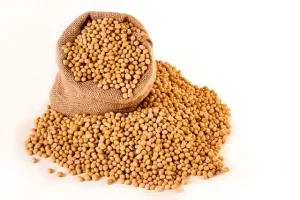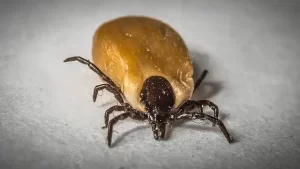Will putting CAR-T cells on the tumors enhance the efficacy?
- Engineered Soybeans with Pig Protein: A Promising Alternative or Pandora’s Dish?
- Severe Fever with Thrombocytopenia Syndrome (SFTS): A Tick-Borne Threat with High Mortality
- Why Isolating Bananas Extends Their Shelf Life?
- This common vitamin benefits the brain and prevents cognitive decline
- New report reveals Nestlé adding sugar to infant formula sold in poor countries
- Did Cloud Seeding Unleash a Deluge in Dubai?
Will putting CAR-T cells on the tumors enhance the efficacy?
- Red Yeast Rice Scare Grips Japan: Over 114 Hospitalized and 5 Deaths
- Long COVID Brain Fog: Blood-Brain Barrier Damage and Persistent Inflammation
- FDA has mandated a top-level black box warning for all marketed CAR-T therapies
- Can people with high blood pressure eat peanuts?
- What is the difference between dopamine and dobutamine?
- How long can the patient live after heart stent surgery?
Will putting CAR-T cells on the tumors enhance the efficacy?
Extract immune T cells from cancer patients, and through genetic engineering, equip them with “chimeric antigen receptors” (CAR) that recognize antigens on the surface of cancer cells, and then infuse the cells back into the patient after a large number of expansions.
Armed with the latest weapons, T cells enter the bloodstream, travel throughout the body, and can relentlessly attack cancer cells once they are identified.
This approach is the CAR-T therapy that has attracted much attention in recent years. For blood cancers such as leukemia and lymphoma, approved CAR-T therapies have benefited many patients. However, for solid tumors, the role of CAR-T therapy has been limited.
Brain tumors, liver cancer, gastric cancer, etc., which we usually call, generally belong to solid tumors, which are often located in specific parts and form dense tumors, which are not easily recognized by immune cells, and it is difficult for CAR-T cells to penetrate and attack cancer cells.
If you want to activate CAR-T cells strongly enough to eradicate tumors, then these cells have to receive high concentrations of activation signals for a long time, and are always ready to replicate quickly and destroy tumors.
Since the main method of administration of CAR-T therapy at present is intravenous injection, this means that as CAR-T cells enter the body, the activation signal required to launch an attack – cytokines will also affect the whole body, often Serious side effects to other parts of the body.
To address this dilemma, engineers at Stanford University have recently developed an ingenious new method of drug delivery that enhances the attack power of CAR-T cells while targeting tumors more precisely in the body, thereby improving the ability of CAR-T to target entities tumor treatment effect.
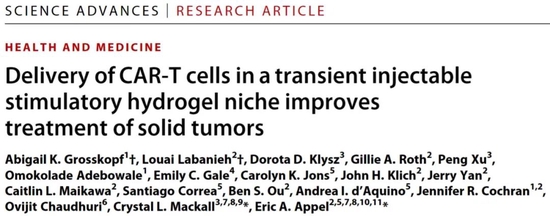
According to their paper published in Science Advances, the researchers designed a hydrogel with a special structure to temporarily “pack” CAR-T cells and stimulatory cytokines together. The gel is “painted” near the tumor with an injection needle, where T cells can grow and proliferate, and are continuously released from the gel to encircle the cancer cells.
▲Schematic diagram of the method: CAR-T cells and cytokines are simultaneously coated next to solid tumors by injecting hydrogel to create a microenvironment suitable for T cells to attack cancer cells (Image source: Reference [1])
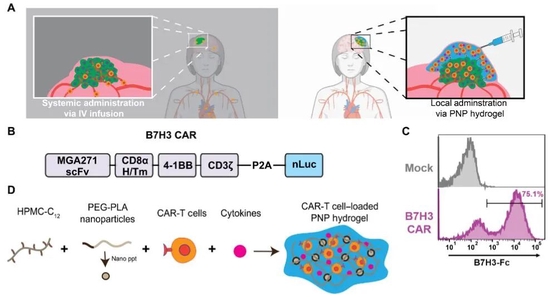 Schematic diagram of the method: CAR-T cells and cytokines are simultaneously coated next to solid tumors by injecting hydrogel to create a microenvironment suitable for T cells to attack cancer cells (Image source: Reference [1])
Schematic diagram of the method: CAR-T cells and cytokines are simultaneously coated next to solid tumors by injecting hydrogel to create a microenvironment suitable for T cells to attack cancer cells (Image source: Reference [1])
The hydrogel consists of water and two components, a polymer made from plant cellulose, and biodegradable nanoparticles. When mixed together, these materials are woven into a fine mesh structure, which prevents the tiny cytokines from diffusing out; at the same time, the connections of this structure are easily pushed apart by cells, and CAR-T cells can be prepared after preparation. Take the initiative to rush out.
“One of the great things about the gels, I think, is that they’re easy to make: you mix the two things together and inject them,” said doctoral student Abigail Grosskopf, lead author of the study.
▲ After the hydrogel is injected from the needle, it quickly forms a solid gel. The needle as shown in the figure is a common specification for human intramuscular injection (Image source: Reference [2]; Credit: Abigail K. Grosskopf)
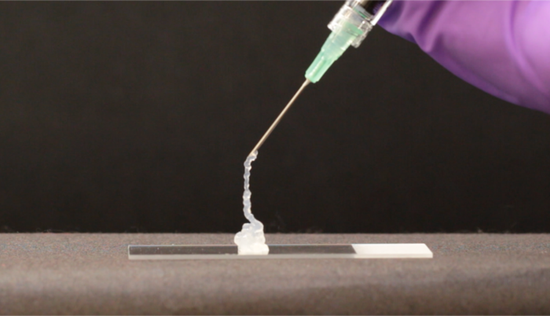 After the hydrogel is injected from the needle, it quickly forms a solid gel. The needle as shown in the figure is a common specification for human intramuscular injection (Image source: Reference [2]; Credit: Abigail K. Grosskopf)
After the hydrogel is injected from the needle, it quickly forms a solid gel. The needle as shown in the figure is a common specification for human intramuscular injection (Image source: Reference [2]; Credit: Abigail K. Grosskopf)
After identifying the best hydrogel formulation for cancer treatment, the team tested it in mice with tumors. In mice subcutaneously implanted with human medulloblastoma, a malignant brain tumor, the tumors disappeared after 12 days after they were injected with a hydrogel containing CAR-T cells and cytokines.
Experiments also showed that the gel was safe, did not induce adverse inflammatory responses in mice, and that the material could be completely degraded within a few weeks.
▲In the mouse experiment, the simultaneous delivery of CAR-T cells and cytokines using hydrogels has a better effect of eradicating tumors, which is better than that of the control group (including intravenous infusion, replacement of hydrogels with normal saline, or water) No cytokines in the gel) (Image source: Reference [1])
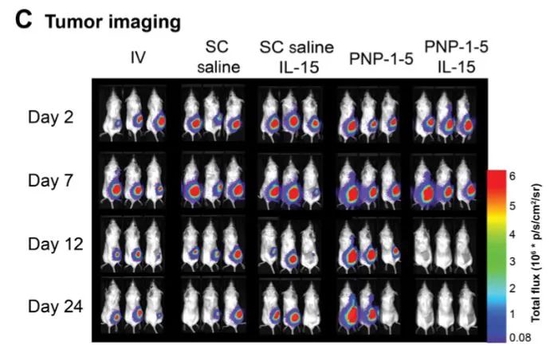
In the mouse experiment, the simultaneous delivery of CAR-T cells and cytokines using hydrogels has a better effect of eradicating tumors, which is better than that of the control group (including intravenous infusion, replacement of hydrogels with normal saline, or water) No cytokines in the gel) (Image source: Reference [1])
In addition to injecting the hydrogel directly next to the tumor, the researchers also tried injecting it on the opposite side of the mouse’s tumor-free body instead. Although the onset of action was doubled due to the distance from the tumor, the researchers were surprised to find that the tumor was eventually eliminated!
“We mainly evaluated those tumors that could be injected next to them, but unfortunately, not all tissues in the body can be injected close to the tumor, so the tumor can be affected by long-distance injection, which is to treat any number of of solid tumors has really opened the door,” said Dr. Eric Appel, who led the study.
The research team said that they will continue to explore the ability of this gel administration method to treat distal tumors.
Scientists hope that this easy-to-make method could make CAR-T cells more effective in the body and eventually tackle the difficult problem of solid tumors.
References:
[1] ABIGAIL K. GROSSKOPF et al. , (2022) Delivery of CAR-T cells in a transient injectable stimulatory hydrogel niche improves treatment of solid tumors. SCIENCE ADVANCES. DOI: 10.1126/sciadv.abn8264
[2] Stanford engineers develop a simple delivery method that enhances a promising cancer treatment. Retrieved Apr. 12, 2022 from https://news.stanford.edu/press/view/43266
Will putting CAR-T cells on the tumors enhance the efficacy?
(source:internet, reference only)
Disclaimer of medicaltrend.org
Important Note: The information provided is for informational purposes only and should not be considered as medical advice.
